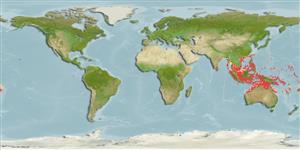Environment: milieu / climate zone / depth range / distribution range
Ecology
Marine; brackish; reef-associated; depth range 5 - 80 m (Ref. 37816). Tropical; 25°N - 21°S
Indo-West Pacific: Thailand to Vanuatu, north to the Ryukyu Islands (Ref. 559) and southeast China, south to Australia.
Size / Weight / Age
Maturity: Lm ? range ? - ? cm
Max length : 25.0 cm TL male/unsexed; (Ref. 48635)
Dorsal spines (total): 15 - 17; Dorsal soft rays (total): 7 - 9; Anal spines: 2; Anal soft rays: 10 - 12. Body colors highly variable and best identified by the patterns on the fins (Ref. 48635). Lower 2 pectoral rays are entirely free and used as "walking" legs and the inner face of the fin is brightly colored (Ref. 37816).
Found on open sandy or silty substrates of lagoon and seaward reefs. Often buries itself and easily overlooked. Uses pectoral fins to startle predators and shows color during courtship (Ref. 48635). Feeds on small fishes and crustaceans (Ref. 9710). The venom of this fish can be deadly to man. Its ability to camouflage itself by living half-buried presents a real danger. Solitary on sand and mud bottoms (Ref 90102).
Life cycle and mating behavior
Maturity | Reproduction | Spawning | Eggs | Fecundity | Larvae
Myers, R.F., 1991. Micronesian reef fishes. Second Ed. Coral Graphics, Barrigada, Guam. 298 p. (Ref. 1602)
IUCN Red List Status (Ref. 130435: Version 2024-1)
Human uses
Fisheries: commercial; aquarium: commercial
Tools
Special reports
Download XML
Internet sources
Estimates based on models
Preferred temperature (Ref.
123201): 26.3 - 29, mean 28.2 °C (based on 1088 cells).
Phylogenetic diversity index (Ref.
82804): PD
50 = 0.5010 [Uniqueness, from 0.5 = low to 2.0 = high].
Bayesian length-weight: a=0.01862 (0.01017 - 0.03409), b=2.90 (2.73 - 3.07), in cm total length, based on LWR estimates for this species & (Sub)family-body (Ref.
93245).
Trophic level (Ref.
69278): 4.0 ±0.66 se; based on food items.
Resilience (Ref.
120179): Medium, minimum population doubling time 1.4 - 4.4 years (Preliminary K or Fecundity.).
Fishing Vulnerability (Ref.
59153): Low vulnerability (15 of 100).
Nutrients (Ref.
124155): Calcium = 55.4 [23.3, 140.2] mg/100g; Iron = 0.564 [0.265, 1.169] mg/100g; Protein = 18 [16, 20] %; Omega3 = 0.197 [0.081, 0.589] g/100g; Selenium = 31.7 [15.2, 76.9] μg/100g; VitaminA = 81.8 [20.5, 340.5] μg/100g; Zinc = 1.22 [0.79, 1.85] mg/100g (wet weight);
